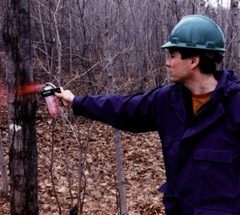As president
of his own company, Ressources Forestières Biotiques, Benoît admits
that he doesn't get outside as much as he would like. "I spend about
80 percent of my time in the office, but the other three technologists
who work with me probably spend 80 percent of their time in the
field."
Working with
companies in the forestry industry as well as with owners of private
woodlots in Quebec's Lanaudiere region, Benoît, 35, surveys the
forests that are slated to be harvested.
He analyzes
the quality and volume of wood that needs to be cut, and checks
the type and height of trees and their density, and the types
of trees growing, among other things. He uses computer software
called the Geographical Information System (GIS) to calculate
the size of the area that will be worked on and helps the forestry
engineer to decide which parts of the forest are to be cut.
Benoît also
handles harvest identification by making a mark on the trunks
of trees to be cut down and supervising the work crews who do
the actual harvesting. He also selects the best place to build
a path so that the workers and their machinery can get into the
forest and the wood can be shipped out.
He also performs
some forestry management tasks such as supervising silviculture
-treeplanting - and forest regeneration operations. After the
work crews have completed their job, Benoît returns to check that
the work has been done properly, and to ensure that the results
are as predicted. Then he writes up a final report.
Benoît also
ensures that forestry company operations in the woods meet government
regulations. Once the wood is in the lumberyard, a forestry harvesting
technologist can also be called upon to measure the volume of
trees that have been cut down for a sawmill or paper mill. He
measures such things as the diameter of trees and checks for flaws
on trunks.
"In a lumberyard
you could have 5,000 cubic feet of trees, for example," Benoît
says. "The wood is piled up on the ground and I measure the diameters
and calculate how much wood is there. This will help the mill
to determine how much it needs, to ensure that each sawmill is
supplied with the precise amount." Then a Quebec government official
checks to see that the measurements are correct.
|


